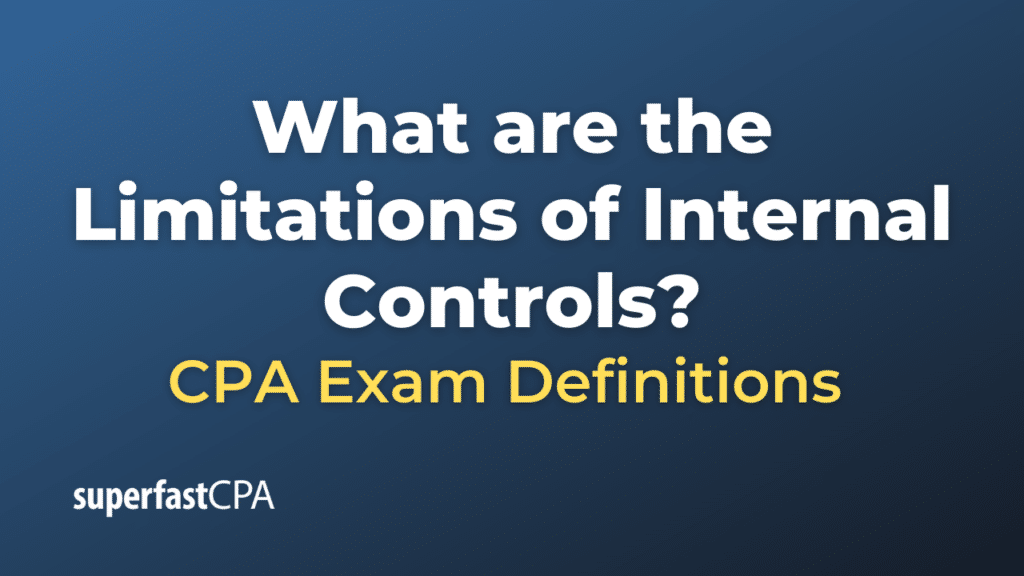Limitations of Internal Controls
Internal controls are systems and procedures implemented by a company to ensure operational effectiveness and efficiency, reliable financial reporting, and compliance with laws and regulations. They also aim to prevent fraud and misuse of resources. However, they do have certain limitations:
- Human Error: Internal controls rely on human action, which means they’re susceptible to mistakes in judgment, misunderstanding, and errors. For example, an employee might misunderstand instructions or fail to follow procedures correctly.
- Management Override: Even with strong internal controls, senior management has the ability to override these controls, which could potentially lead to fraudulent activities.
- Collusion: Internal controls are often designed with the assumption that no collusion will occur among employees. If two or more employees collude to circumvent the controls, they can engage in fraud or misuse of resources.
- Resource Constraints: Implementing and maintaining effective internal controls can be expensive and time-consuming, especially for small businesses with limited resources.
- Change Management: The business environment, including technologies, regulations, and threats, is constantly changing. Internal controls that were effective in the past might become obsolete or less effective over time if they’re not regularly updated.
- Limited Scope: Internal controls, no matter how well designed, cannot provide absolute assurance in regard to achievement of a company’s objectives. For example, they can’t prevent external events such as a sudden market downturn, or internal factors like poor strategic decisions.
- Cost-Benefit Consideration: While it’s theoretically possible to eliminate almost all risks with extremely strong controls, in practice this isn’t economically feasible. Companies must balance the cost of implementing controls against the potential benefits, which means accepting that some risk will remain.
It’s important for companies to understand these limitations when designing and implementing their internal controls. Even with these limitations, effective internal controls can greatly reduce, but not entirely eliminate, the risk of fraudulent activity, errors, and operational inefficiencies.
Example of the Limitations of Internal Controls
Suppose a company, we’ll call it “RetailCo”, has set up a control procedure where all expense claims by employees need to be approved by their direct manager before they’re paid out. This control is intended to prevent fraudulent or erroneous expense claims.
Now, let’s see how limitations of internal controls can affect this scenario:
- Human Error: An employee, John, might make a mistake while submitting his expense claim, perhaps entering a wrong amount. Despite the control in place, this erroneous claim might still be approved by his manager who failed to notice the mistake.
- Management Override: The manager, instead of rigorously checking each expense claim, might decide to approve all of them without a detailed review, effectively overriding the internal control. This could potentially result in fraudulent or erroneous claims being approved.
- Collusion: John and his manager could collude to submit and approve fraudulent expense claims. Even with the control in place, this collusion could enable them to defraud the company.
- Resource Constraints: RetailCo might not have enough resources to implement a more rigorous review process, like having a separate internal audit team to randomly check expense claims. So, while the existing control reduces the risk of fraud, it can’t eliminate it.
- Change Management: If the company shifts to a remote work setup, employees might start incurring new types of expenses. If the control procedures aren’t updated to reflect these changes, they might become less effective.
- Limited Scope: Despite the control procedure, RetailCo might still suffer from other issues like poor sales performance or losses from other areas of operations. Internal controls can’t guarantee the overall success of the business.
- Cost-Benefit Consideration: RetailCo could theoretically enforce a rule where all expense claims have to be audited by an external party before being approved. However, the cost of such a measure would likely outweigh the benefits, demonstrating the need for a balance between cost and control effectiveness.
This example shows how, even though internal controls are vital for managing risks within a company, they have limitations and can’t provide absolute assurance against all types of risks.













